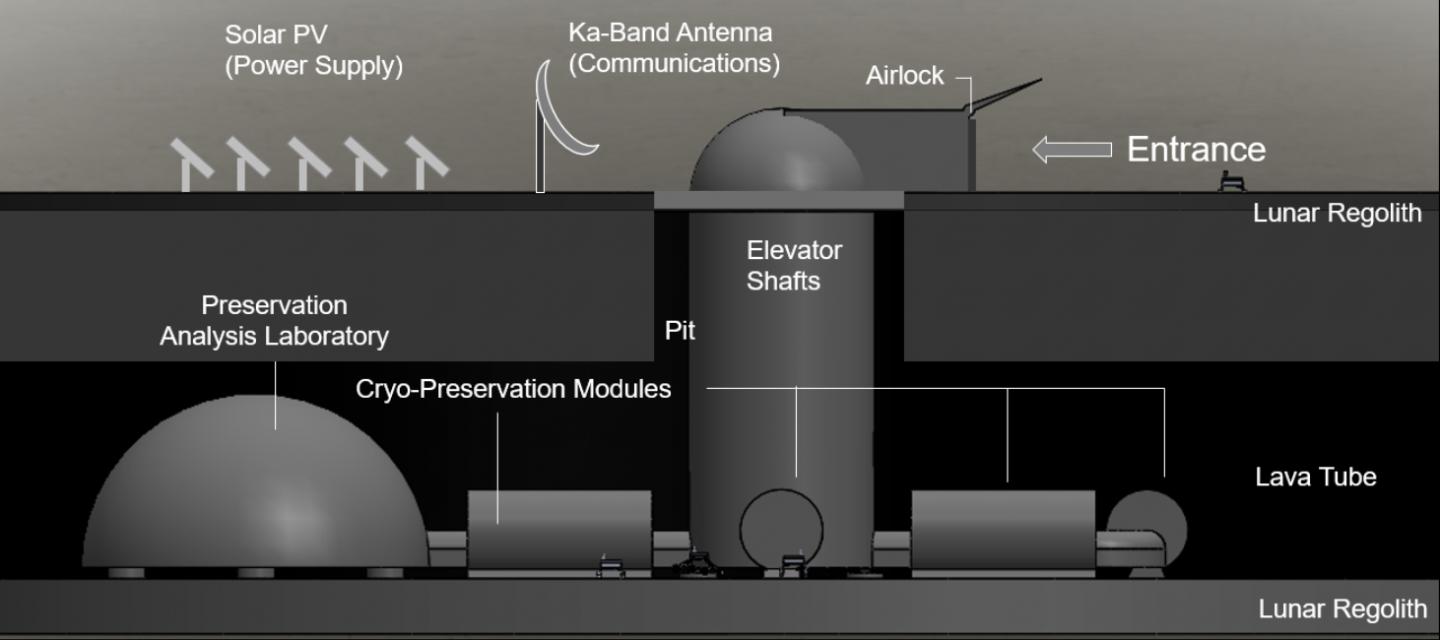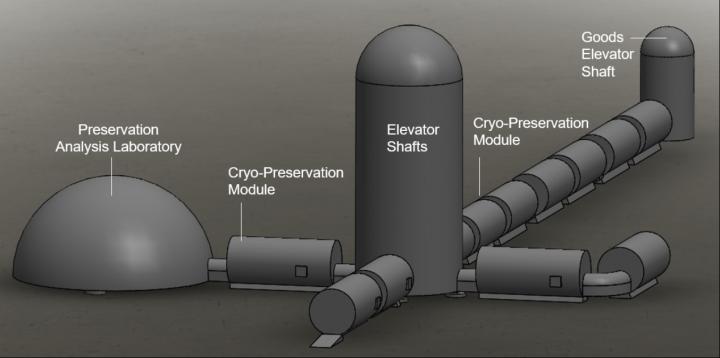Scientists want to store DNA of 6.7 million species on the moon, just in case
The 'lunar ark' would be hidden in lava tubes.

A "lunar ark" hidden inside the moon's lava tubes could preserve the sperm, eggs and seeds of millions of Earth's species, a group of scientists has proposed.
The ark, or gene bank, would be safely hidden in these hollowed-out tunnels and caves sculpted by lava more than 3 billion years ago and would be powered by solar panels above. It would hold the cryogenically preserved genetic material of all 6.7 million known species of plants, animals and fungi on Earth, which would require at least 250 rocket launches to transport to the moon, according to the researchers.
Scientists believe the endeavor could safeguard our planet's wildlife against both natural and human-caused apocalyptic scenarios, such as a supervolcano eruption or a nuclear war, and ensure the survival of their genes.
Related: Interstellar space travel: 7 futuristic spacecraft to explore the cosmos
The scientists presented their lunar ark plans on Sunday (March 7) at the IEEE Aerospace Conference, which was held virtually this year due the COVID-19 pandemic.
"There's this strong interconnectedness between us and nature," lead author Jekan Thanga, head of the Space and Terrestrial Robotic Exploration (SpaceTREx) Laboratory at the University of Arizona, told Live Science. "We have a responsibility to be guardians of biodiversity and the means to preserve it."
Not all the technology needed for this ambitious project exists yet, but the researchers think that it could realistically be built within the next 30 years, Thanga said.
Get the world’s most fascinating discoveries delivered straight to your inbox.
Existential threats
The main motivation behind the lunar ark is to create a secure off-world storage facility for biodiversity.
"I like to use the data analogy," Thanga said. "It's like copying your photos and documents from your computer onto a separate hard drive, so you have a backup if anything goes wrong."
Therefore, if an apocalyptic event destroyed the natural world or wiped out most of humanity, there would be a chance to "hit a reset button," Thanga said.
In their presentation, the researchers listed the following as potential existential threats to biodiversity on Earth: Supervolcanic eruption, global nuclear war, asteroid impact, pandemic, climate change acceleration, global solar storm and global drought.
Related: Doomsday: 9 real ways the Earth could end
"The environment and human civilization are both very fragile," Thanga said. "There are many of these really tragic circumstances that could happen."
Creating genetic back-ups to preserve biodiversity is not a new concept. The Svalbard Global Seed Vault, located within the Arctic Circle in Norway, holds the genetic samples of plant species from around the world and has already been used to reintroduce certain plants back into the wild. However, that vault is still at risk of being destroyed by rising sea levels or an asteroid strike.
Only by storing the genetic information somewhere else in the solar system can we ensure it survives any existential threats to Earth, the researchers said.
Lava tubes
The moon was the obvious choice for an off-world ark for one main reason: It is only a four-day journey from Earth, which means transporting the samples is much easier than taking them to Mars. Building an ark in orbit around Earth is also not secure enough due to the instability of orbit, Thanga said.
However, another benefit of building an ark on the moon is that it can be safely hidden away in lava tubes. These hollowed-out caverns and tunnels under the surface were formed during the moon's fiery infancy, and they have remained untouched ever since. Lava tubes would protect the ark from meteor strikes and DNA-damaging radiation. The lava tubes have also been suggested as excellent places to build lunar cities for a human civilization on the moon as well, as previously reported by Live Science.

"Unless there is a direct hit from a meteor or a nuclear strike, the ark should be okay," Thanga said. "And there could be as many as 200 lava tubes that could be suitable for the ark."
The researchers propose to first map these tubes using specially designed robots capable of autonomously exploring the caverns and tunnels. The hypothetical SphereX robots would resemble large "pokeballs" with a dark metallic grey upper half and bronze lower half, according to Thanga. The SphereX robots would be capable of hopping around in the moon's low gravity and mapping the tubes using cameras and LIDAR — a remote sensing method that uses light in the form of a pulsed laser to measure distances.
Once the robots identify a suitable lava tube then the construction phase could begin.
Building the base
The proposed ark would include two main sections above and below ground. The genetic samples would be kept in cryostorage modules inside the lava tubes that would be connected to the surface by elevators. On the surface, a communications array and solar panels would allow the ark to be maintained autonomously and an airlock would allow for human visitors.

Building the ark would be a huge logistical challenge, but Thanga said that upcoming moon missions by NASA and the European Space Agency (ESA) will lay the groundwork for these types of construction projects.
Thanga predicts that transporting the samples to the moon will be the most challenging and costly aspect of building the ark, Based on some "quick, back-of-the-envelope calculations," he said.
Those calculations assume that 50 samples of each species would be needed to successfully reintroduce a species. However, reintroducing each species could actually take as many as 500, which would mean many more rockets were needed, Thanga said. These calculations also don't include the launches needed to transport the necessary materials to build the ark in the first place.
"It will cost hundreds of billions of dollars to build the ark and transport samples," Thanga said. "But this isn't totally out of the question for international collaborations like the U.N."
Super-cold robots
Even so, one aspect of the lunar ark is currently out of reach.
In order for the samples to be cryogenically preserved, they must be stored at extremely low temperatures between minus 292 and minus 321 degrees Fahrenheit (minus 180 to minus 196 degrees Celsius). This means that it would be impractical to use humans to sort and retrieve samples from the cryostorage modules. Instead, robots would have to do the heavy lifting.
But at such low temperatures, the robots would freeze to the floor via cold welding, where metals fuse together under freezing temperatures. The solution, according to the researchers, is quantum levitation. This theoretical solution is basically a supercharged version of magnetism using superconductive materials to fix objects in a magnetic field.
"You can have things at a distance being pinned together, so you can move the robots via levitation," Thanga said. "It's as if you know, they have invisible strings or ropes attached to them."
Quantum levitation isn't possible yet, but it will also be needed in the future for other cryogenic projects like long-haul space travel, so it is only a matter of time before someone works out how to do it, Thanga said.
The researchers say that a 30-year timeframe is possible, but if humanity were faced with an imminent existential crisis it could be done much faster, Thanga said.
"This is a project that would require real urgency to have a lot of people energized enough to go after it," Thanga said. "I think it could be achieved within 10 to 15 years if needed."
Originally published on Live Science.

Harry is a U.K.-based senior staff writer at Live Science. He studied marine biology at the University of Exeter before training to become a journalist. He covers a wide range of topics including space exploration, planetary science, space weather, climate change, animal behavior and paleontology. His recent work on the solar maximum won "best space submission" at the 2024 Aerospace Media Awards and was shortlisted in the "top scoop" category at the NCTJ Awards for Excellence in 2023. He also writes Live Science's weekly Earth from space series.


